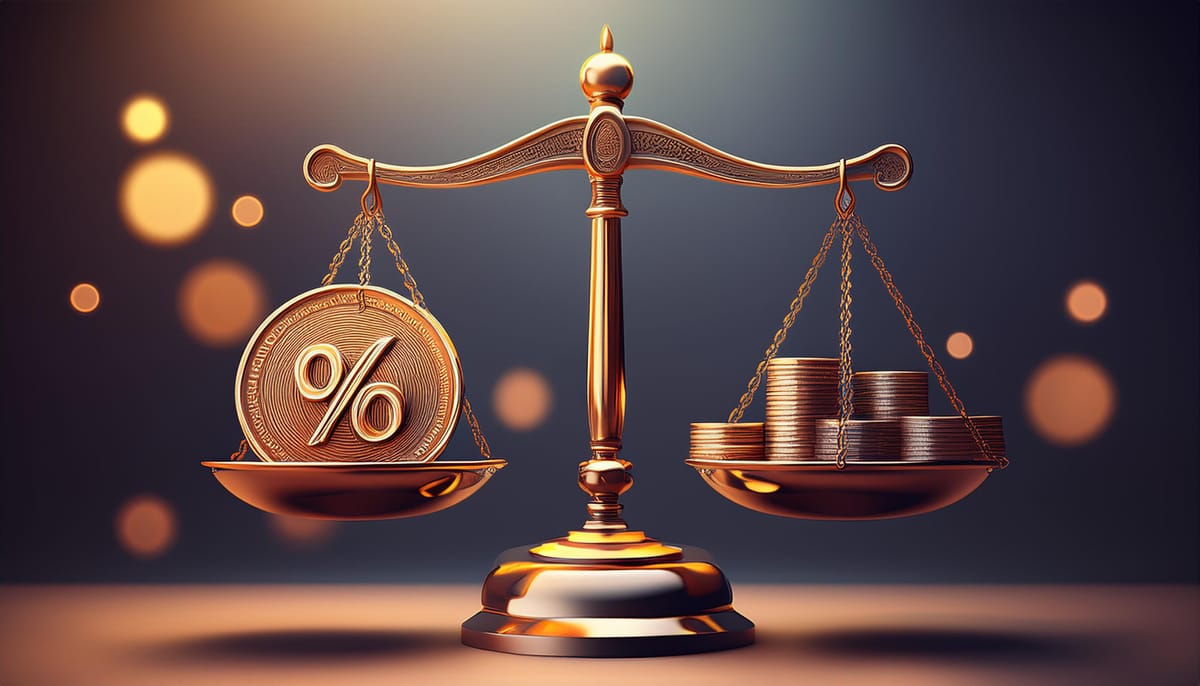Discover how the discount rate dramatically impacts DCF valuations. Learn to navigate this crucial element for more accurate financial analyses and smarter investment decisions.
In the world of finance, few tools are as powerful or widely used as Discounted Cash Flow (DCF) analysis. At the heart of this valuation method lies a crucial element: the discount rate. This seemingly simple percentage has the power to dramatically alter the perceived value of investments, companies, and projects. But what exactly is the discount rate, and why does it wield such influence over DCF valuations?
Imagine you’re offered $1,000 today or $1,100 a year from now. Which would you choose? Your decision largely depends on how you value future money compared to present money - and that’s essentially what the discount rate represents in financial calculations, much like how compound interest allows money to grow over time by earning interest on both the initial principal and previously accumulated interest.
The discount rate is like a financial time machine. It translates future cash flows into present-day values, accounting for the time value of money and the risk associated with those future cash flows. In DCF analysis, it’s the rate used to determine the present value of estimated future cash flows.
But here’s where it gets interesting: even small changes in the discount rate can lead to significant swings in valuation. It’s like adjusting the lens through which we view future financial prospects. A higher discount rate shrinks the present value of future cash flows, while a lower rate magnifies them.
Let’s dive deeper into how the discount rate impacts DCF valuation and why it’s so crucial for investors, analysts, and financial decision-makers to understand its nuances.

The Inverse Relationship: Discount Rate and Valuation
The relationship between the discount rate and DCF valuation is inverse, meaning they move in opposite directions. This fundamental principle is key to understanding how changes in the discount rate ripple through a valuation model.
Here’s a simple way to visualize this relationship:
| Discount Rate | Impact on Valuation |
|---|---|
| Increases | Decreases |
| Decreases | Increases |
Why does this happen? It all comes down to the time value of money. A higher discount rate implies that future cash flows are worth less today, which reduces the overall valuation. Conversely, a lower discount rate suggests that future cash flows are more valuable in present terms, leading to a higher valuation.
Think of it like this: if you’re promised $1,000 in 10 years, how much would you be willing to pay for that promise today? If you use a high discount rate, say 10%, that future $1,000 is worth only about $386 today. But if you use a lower discount rate, like 5%, it’s worth about $614 today. The lower discount rate results in a higher present value. This higher present value is also referred to as the discounted value, which reflects the present worth of the future amount factoring in rates of return and risks.
This principle applies to all future cash flows in a DCF model. The further into the future a cash flow is projected, the more pronounced the impact of the discount rate becomes. This is due to the compounding effect of discounting over time. The discount rate is calculated as a ratio of interest earned to the future value, contrasting it with the traditional interest rate that is calculated using the present value. This ratio is also known as the discount yield, which reflects the proportional cost of delaying a payment and is integral to determining the present value of future cash flows.
For example, a 1% change in the discount rate might have a relatively small impact on cash flows expected next year. But for cash flows projected 10 or 20 years into the future, that same 1% change can result in a significant difference in present value.
This sensitivity to the discount rate is why financial analysts often perform extensive sensitivity analyses when conducting DCF valuations. By adjusting the discount rate and observing the resulting changes in valuation, they can better understand the range of possible outcomes and the robustness of their valuation model.
Risk and Required Return: The Building Blocks of the Discount Rate
The discount rate isn’t just an arbitrary number plucked from thin air. It’s a carefully considered estimate that reflects two key factors: risk and required return. Understanding these components is crucial for selecting an appropriate discount rate and interpreting DCF valuations.
Risk, in financial terms, refers to the uncertainty or variability of future cash flows. The greater the perceived risk, the higher the discount rate. This makes intuitive sense - if we’re less certain about future cash flows, we want to value them more conservatively today.
Several types of risk can influence the discount rate:
- Business risk: This includes factors like competitive pressures, industry volatility, and operational leverage.
- Financial risk: Higher debt levels and financial leverage increase risk.
- Market risk: Overall economic conditions and market volatility play a role.
- Liquidity risk: Less liquid investments may require a higher discount rate.
- Country risk: Investments in emerging or volatile markets often demand higher rates.
Required return, on the other hand, represents the minimum rate of return an investor demands to compensate for these risks. It’s essentially the opportunity cost of capital - what an investor could earn on an alternative investment with similar risk.
A common method for estimating the required return is the Capital Asset Pricing Model (CAPM). This model takes into account the risk-free rate (often based on government bond yields), the market risk premium, and a company-specific beta that measures its volatility relative to the market.
Here’s a simplified version of how these factors might influence the discount rate:
| Factor | Low Risk/Return | High Risk/Return |
|---|---|---|
| Business/Industry Risk | 1-3% | 5-7% |
| Financial Leverage | 0-1% | 2-4% |
| Market Risk Premium | 4-6% | 6-8% |
| Country Risk (if applicable) | 0-2% | 3-5% |
| Liquidity Premium | 0-1% | 2-3% |
The total discount rate would be the sum of these components plus the risk-free rate. Understanding relative value is essential for decision-makers to assess the costs and benefits of future policies, as it helps translate future values into present values.
By understanding these building blocks, investors and analysts can make more informed judgments about the appropriate discount rate to use in their DCF models. This, in turn, leads to more accurate and reliable valuations.

Key Considerations When Determining the Discount Rate Calculation
Selecting the right discount rate is both an art and a science. It requires a blend of quantitative analysis, industry knowledge, and judgment. Here are some key considerations to keep in mind when determining an appropriate discount rate for DCF valuation:
- Cost of Capital: The discount rate should reflect the company’s weighted average cost of capital (WACC). This includes both the cost of equity and the cost of debt, weighted by their proportions in the company’s capital structure.
- Industry Benchmarks: While each company is unique, industry averages can provide a useful starting point. For example, tech startups might use higher discount rates due to their inherent risk, while utilities might use lower rates reflecting their stability.
- Growth Expectations: Rapidly growing companies might warrant lower discount rates, as their future cash flows are expected to increase more quickly. However, this needs to be balanced against the increased uncertainty that often comes with high growth.
- Time Horizon: Longer-term projections typically use higher discount rates due to increased uncertainty further into the future.
- Market Conditions: Prevailing interest rates and overall economic conditions influence the appropriate discount rate. Money deposited in a bank account can earn interest over time, illustrating the time value of money. In low-interest-rate environments, discount rates tend to be lower.
- Company Size: Smaller companies often have higher discount rates applied due to increased risk and volatility. This is sometimes referred to as the “small firm effect”.
- Stage of Business: Early-stage companies typically have higher discount rates than mature businesses, reflecting their higher risk profile.
- Leverage: More highly leveraged companies generally require higher discount rates due to increased financial risk.
- Inflation Expectations: The discount rate should account for expected inflation over the projection period. Higher inflation expectations typically lead to higher discount rates.
- Comparable Company Analysis: Looking at the implied discount rates used in the valuations of similar companies can provide valuable insights.
Here’s a simplified table showing how some of these factors might influence the discount rate:
| Factor | Lower Discount Rate | Higher Discount Rate |
|---|---|---|
| Company Size | Large Cap | Small Cap |
| Business Stage | Mature | Start-up |
| Financial Leverage | Low Debt | High Debt |
| Growth Expectations | Stable, Low Growth | High Growth |
| Industry | Utilities, Consumer Staples | Tech, Biotech |
Remember, these are general guidelines. The specific circumstances of each valuation will dictate the appropriate adjustments to the discount rate.
By carefully considering these factors, analysts can develop a discount rate that appropriately reflects the risk and required return for the specific investment being valued. This thoughtful approach leads to more accurate DCF valuations and, ultimately, better investment decisions.

Sensitivity Analysis: Understanding the Impact of Discount Rate Changes on Future Cash Flows
Given the significant influence of the discount rate on DCF valuations, it’s crucial to understand how changes in this rate can affect the final valuation. This is where sensitivity analysis comes into play.
Sensitivity analysis involves recalculating the DCF valuation using a range of discount rates. This process reveals how sensitive the valuation is to changes in the discount rate and provides valuable insights into the robustness of the valuation model.
Here’s why sensitivity analysis is so important:
- Valuation Range: It provides a range of possible valuations based on different discount rates, giving a more complete picture than a single-point estimate.
- Risk Assessment: By showing how much the valuation changes with different discount rates, it helps quantify the impact of uncertainty in the discount rate estimate.
- Decision Making: Understanding the sensitivity of the valuation to the discount rate aids in making more informed investment decisions.
- Critical Values: It can reveal discount rate thresholds that significantly change the investment’s attractiveness.
- Scenario Planning: Allows for analysis of best-case, worst-case, and most likely scenarios.
A typical sensitivity analysis might look something like this:
| Discount Rate | Valuation (in millions) |
|---|---|
| 8% | $120 |
| 9% | $110 |
| 10% | $100 |
| 11% | $92 |
| 12% | $85 |
This table shows how the valuation changes with different discount rates. In this example, a 1% increase in the discount rate from 10% to 11% results in an 8% decrease in valuation. Estimating the present value of future payment is crucial as it highlights the time value of money, indicating that a dollar today is worth more than a dollar in the future.
It’s important to note that the relationship between the discount rate and valuation is often non-linear. Small changes in the discount rate can sometimes lead to disproportionate effects on the valuation, especially for long-term projects or high-growth companies.
Sensitivity analysis also helps identify the discount rate’s “break-even” point - the rate at which the investment’s net present value (NPV) becomes zero. Discounting transforms a future sum of money into its present value through a discount rate, providing a clearer picture of the investment's worth today.
By incorporating sensitivity analysis into their DCF models, investors and analysts gain a more comprehensive understanding of how the choice of discount rate affects the valuation. This leads to more robust valuations and better-informed investment decisions.
FAQ
Q: What is a typical discount rate for DCF valuation? A: Typical discount rates can range from 6% to 20% or higher, depending on the industry, company size, and risk profile. For established companies in stable industries, rates of 8-12% are common, while high-growth or risky ventures might use rates of 15-20% or more.
Q: How does inflation affect the discount rate? A: Higher inflation expectations typically lead to higher discount rates. The discount rate should include a real return component plus expected inflation to arrive at a nominal rate.
Q: Can the discount rate be negative? A: While theoretically possible in deflationary environments, negative discount rates are extremely rare in practice. Most DCF models use positive discount rates.
Q: How often should I update the discount rate in my DCF model? A: It’s good practice to review and potentially update your discount rate annually or when significant changes occur in the company’s risk profile, capital structure, or market conditions.
Q: How do future values impact decision-making in DCF valuation? A: Future values are crucial in evaluating costs and benefits over time, impacting decision-making in policy analysis and investment choices.
Understanding the impact of discount rates on DCF valuation is crucial for making informed investment decisions. Want to deepen your knowledge of financial analysis? Explore our other articles on valuation methods and financial modeling. And don’t forget to sign up for our newsletter to stay updated on the latest insights in finance and investing!





